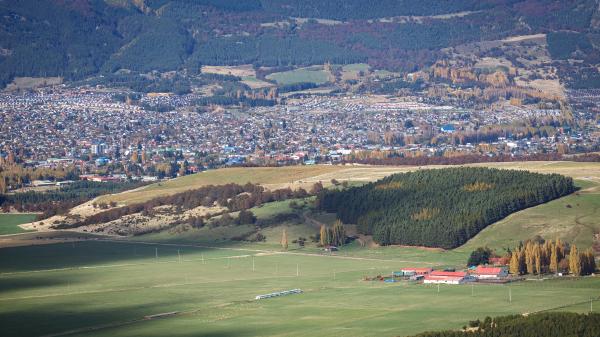Solar Eclipses in 2017
The Moon and the Sun move across our sky with clockwork precision. As a result, there will be 2 solar eclipses this year: 1 annular and 1 total.

Annular solar eclipse in Huambo, Angola.
©Abanul/Wikimedia Commons
An annular eclipse occurs when the Moon is too far away to cover the Sun completely: the result is a dramatic "ring of fire" around the Moon.
Annular Eclipse Feb 26, 2017
On February 26, there will be an annular eclipse in the southern hemisphere. The annular phase of the eclipse (the ring of fire) will be visible along a narrow "path of annularity" that begins at sunrise in the South Pacific and ends at sunset in central Africa.
Watch It Live on timeanddate.com
timeanddate.com will host a live broadcast of the annular solar eclipse from Angola, where the annular solar eclipse will be visible in all its glory, weather permitting, of course.
2 of the first places to witness annularity will be the cities of Puerto Aysén and Coyhaique in southern Chile. Here, the ring of fire will last 1 minute. The path of annularity then passes through Argentina's Chubut Province, before heading out across the South Atlantic towards central Africa.

Coyhaique in Patagonia, Chile.
©iStockphoto.com/Dmitry_Saparov
2 1/2 hours after leaving South America, the ring of fire reaches the coastal settlement of Bentiaba in Angola. 3 minutes after that, it arrives at the biggest urban area on its route: Huambo, Angola's second-largest city. Finally, having passed through the tip of Zambia's North-Western Province, the path of annularity ends in the Democratic Republic of the Congo, where residents of the city of Likasi, near Lubumbashi, will witness a spectacular ring-of-fire sunset.
Same Eclipse Partial Elsewhere
Outside the path of annularity, the lower half of South America and most of sub-Saharan Africa will get a partial solar eclipse. São Paulo, for example, will have a 40% partial eclipse (where 40% of the Sun is covered by the moon); Lagos will have a 24% partial eclipse. The percentages shown here are for obscuration, not magnitude.
timeanddate.com Gets Involved!
timeanddate.com will be helping young people in Angola make the most of the once-in-a-lifetime experience of an annular eclipse. We're sponsoring a program called Global Communication and Science, which uses solar eclipses as 'teachable moments' to inspire, educate and connect students in different countries.

Total solar eclipse in Palu, Indonesia.
©timeanddate.com/Graham Jones
The Global Communication and Science team will be running a series of public outreach events at the Instituto Superior de Ciências de Educação (ISCED) in Huambo; they will also be organizing classroom activities in schools across the country.
Hope for Clear Skies
Unfortunately, there is an important aspect of eclipse-watching we can never calculate with certainty: the weather. The average cloud cover in Huambo during February and March is 70%. In South America: the average cloud cover in 70% in Puerto Aysén, 60% in Coyhaique, and as low as 40% near the border between Chile and Argentina.
If the weather disappoints in your area, you can watch timeanddate.com's LIVE broadcast or our eclipse animations, which will also be in real-time on the day.
Protect Your Eyes!
Never look directly at the Sun without proper eye protection. You can seriously hurt your eyes, and even go blind.
DIY: Pinhole projector for eclipses
Total Eclipse in the US in Aug 2017
A total solar eclipse that crosses the US from coast to coast on August 21, 2017 is being called the Great American Eclipse.
Watch the Total Solar Eclipse
timeanddate.com will host a LIVE broadcast of this total solar eclipse from the US, where the totality will be visible for 2 minutes and 40 seconds.
Infographic on total solar eclipses

Nashville, Tennessee, USA.
©iStockphoto.com/SeanPavonePhoto
A total eclipse occurs when the Moon is close to Earth and covers the Sun completely. Totality is only visible along a narrow corridor called the path of totality.
On August 21, the path of totality will be just 155 km (70 miles) wide, and will run through 14 US states: Oregon, Idaho, Montana (a tiny bit), Wyoming, Nebraska, Kansas, Iowa (a tiny bit), Missouri, Illinois, Kentucky, Tennessee, Georgia, North Carolina, and South Carolina.
The largest city on the path of totality is Nashville, Tennessee. The longest period of totality will be at a point close to Hopkinsville, Kentucky—where the totality will be visible for 2 minutes and 40 seconds.
The best weather prospects are in central Oregon, southwest and southeast Idaho, and central Wyoming. According to meteorologist Jay Anderson, the average cloud cover on 21 August drops to as low as 15% in these areas.
Partial Eclipse in North and South America
The whole of North America and the upper part of South America will experience a partial eclipse. New York City, for instance, will have a 72% partial eclipse; while people in Mexico City will witness a 27% partial eclipse.
Graham Jones is a British astrophysicist and language teacher based in Japan; he began the “Global Communication and Science” educational program in 2015.